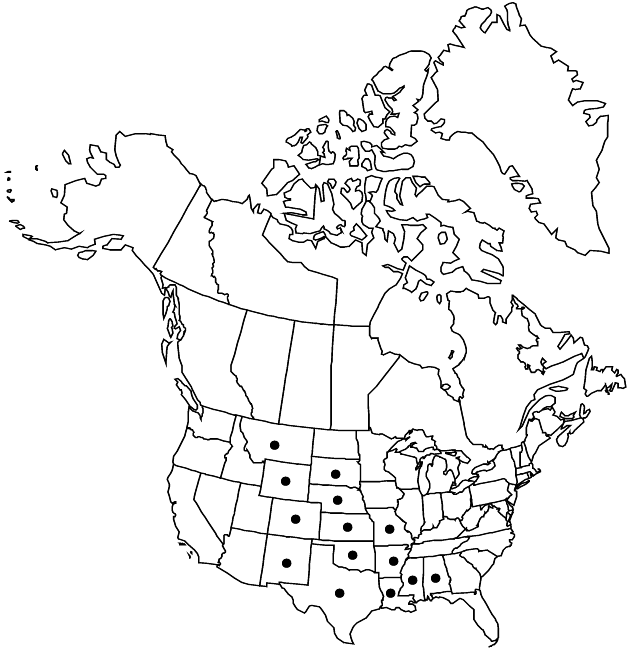Diaperia prolifera
Trans. Amer. Philos. Soc., n. s. 7: 338. 1840.
Plants grayish green to silvery, 3–15 cm, sericeous to lanuginose. Stems mostly 2–10; branches proximal and distal (distal opposite or, sometimes, appearing alternate when unequal), rarely none. Leaves: largest 7–15 × 2–4 mm; capitular leaves subtending glomerules, also visible between and surpassing heads. Heads in strictly dichasiform or pseudo-polytomous arrays (sometimes appearing monochasiiform), cylindric to ± ellipsoid, 3.5–4.5 mm, heights 2–3 times diams. Receptacles broadly or narrowly conic, 0.4–0.6 mm or ± 0.9–1.1 mm, heights 0.5–0.7 or 2–2.4 times diams. Pistillate paleae imbricate, longest 2.5–4 mm. Staminate paleae ± 3, apices erect to somewhat spreading, ± plane. Functionally staminate florets 2–4; ovaries partly developed, 0.4–0.6 mm; corollas hidden in heads, actinomorphic, 1.4–2 mm, glabrous, lobes equal. Bisexual florets 0. Cypselae ± angular, obcompressed, mostly 0.9–1.2 mm.
Distribution

Ala., Ark., Colo., Kans., La., Miss., Mo., Mont., N.Mex., Nebr., Okla., S.Dak., Tex., Wyo.
Discussion
Varieties 2 (2 in the flora).
Intermediates between the two varieties of Diaperia prolifera occur where their ranges meet in central Texas and central Oklahoma. The strictly dichasiform or pseudo-polytomous branching pattern of D. prolifera is distinctive and diagnostic within the genus. Specimens of D. prolifera from introductions around a wool mill in South Carolina (G. L. Nesom 2004c, as Evax prolifera) are as yet undetermined to variety and are not included in the distributions below.
Selected References
None.
Key
| 1 | Plants grayish to greenish, loosely lanuginose; heads 4–40+ in largest glomerules; receptacle heights mostly 0.5–0.7 times diams.; capitular leaves usually ± spreading, scarcely involucral, not or scarcely carinate, pliant to somewhat rigid; distal branches mostly spreading to ascending; longest pistillate paleae 3.3–4 mm | Diaperia prolifera var. prolifera |
| 1 | Plants silvery white, tightly sericeous; heads borne singly, or 2–3 in largest glomerules; receptacle heights mostly 2–2.4 times diams.; capitular leaves erect, involucral, proximally carinate, becoming indurate; distal branches strictly ascending to erect; longest pistillate paleae 2.5–3.2 mm | Diaperia prolifera var. barnebyi |